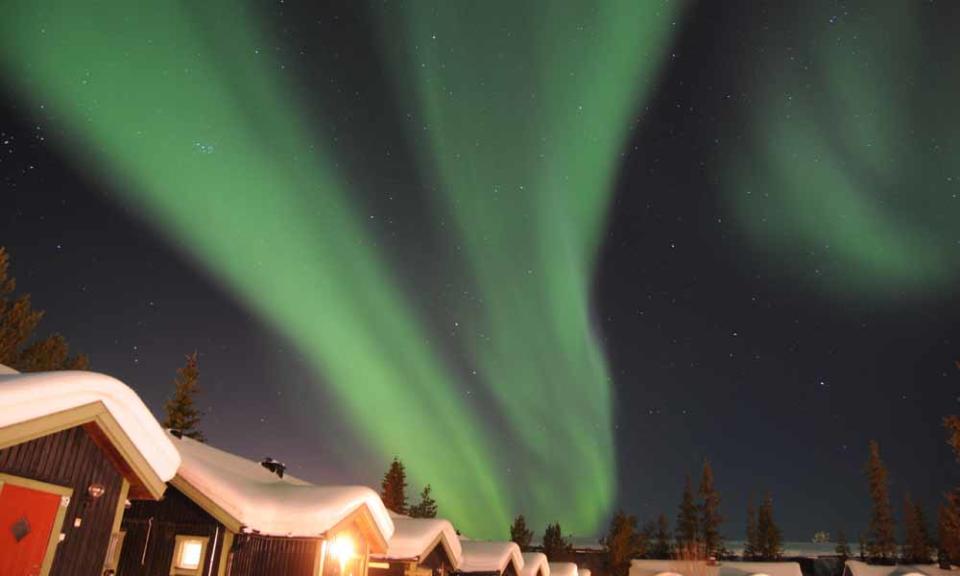Best viewing tips for the Northern Lights

Brits may get another chance to glimpse the Northern Lights as the rare celestial event is expected to shine even brighter on Tuesday night – and could be visible across all of the UK.
On Sunday night, rays of shimmering green and red lights were seen in the skies as far south as Yorkshire and Ireland, with reports of purples, yellows, oranges and even neon green also filling the sky.
2012 is predicted to be one of the best years yet to view the Northern Lights, also known as the Aurora Borealis, due to the peak in solar activity.
[Related story: Biggest solar storm since 2005 pummels Earth]
According to Nasa’s Goddard Space Weather Centre, it is predicted that a coronal mass ejection – a cloud of charged particles – heading towards the Earth’s magnetosphere, has the potential to produce good Auroral displays - and possibly at lower latitudes than normal.
The Northern Lights are created by these charged particles colliding with the Earth's upper atmosphere.
[See also: The spectacular Northern Lights in pictures]
The particles cause a change in atoms of the upper atmosphere that release light as they return to their normal state.
The sun threw off its biggest solar flare in six years on Monday, which has pulled the Northern Lights further south. It is expected to hit the Earth on Tuesday afternoon (local time), according to Nasa, so at nightfall Brits living as far south as London could get a peek at the spectacle.
Speaking with Yahoo! News on Tuesday, astronomer and broadcaster Robin Scagell said the last Northern Lights display seen this far south was in April 2000. He described the previous event as “spectacular”.
If you think you’ve missed the boat of the awesome light show, don’t worry. Here are some tips for some perfect Northern Lights viewing…
Top viewing tips
1. For a better glimpse of the Aurora Borealis, look towards the northern sky or head north. Traditionally people believe that the best places to view the Northern Lights are the very tip of Scotland or the icy tundra of the Arctic Circle. However, experts predict that Tuesday’s display could be seen as far south as London. But for double assurance, head to northern spots.
2. As it’s a new moon, the display won’t be hampered by moonlight. Even so, keep away from urban areas for the darkest night skies.
3. Clear skies allow for the best views so before venturing out to catch the awesome display, check your local weather forecast.
4. The Northern Lights can be seen at anytime in the night sky. Displays may last from a few minutes to a few hours at a time, so make sure you give yourself enough time to catch it.
5. When catching the event on a photo, Scagell said the Aurora can be photographed well using a digital camera with an ISO setting of 1600. Remember to turn the flash off first.
6. Find a rural area away from street lights and pollution. The National Trust has listed the best spots on its website to go stargazing, including Stonehenge. Here is a list of some more of the best places to watch the Aurora Borealis.
North
Buckstones Car Park
Marsden Moor, Yorkshire
Friar's Crag
Lake District, Cumbria
Midlands
Mam Tor
Peak District, Derbyshire
South
Bignor Car Park
Slindon Estate, West Sussex
Dunkery Beacon
Holnicote Estate, Exmoor
Echo Mount
Knole, Kent
Black Down
Sussex
Northern Ireland
Divis Mountain
Belfast
Wales
Penbryn Beach
Cardigan
Scotland
Galloway Forest Park
Dumfries and Galloway
Sighthill Park
Glasgow
New Lanark Roof Garden
Lanark
Did you catch a glimpse of the Northern Lights? Tell us about it below

 Yahoo News
Yahoo News 
